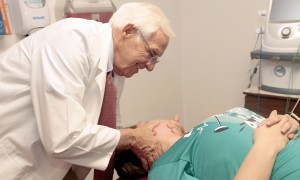
What is Osteopathic Medicine and OMT?
You may have seen DO at the end of a physician’s name but not known the meaning behind this degree. It stands for doctor of osteopathic medicine, and these doctors are trained in modern medicine as well as holistic medicine based on the philosophy that the body is an integrated whole. They receive special instruction in the musculoskeletal system and osteopathic manipulative therapy (OMT), a hands-on approach to diagnosing and treating patients. Bayhealth Primary Care Physician Vincent Lobo, DO, DACFP, who has been performing OMT in his practice for over 40 years, discusses its uses and benefits.
The premise behind osteopathic or holistic medicine is that the mind, spirit, and structure and function of the body are interdependent. “Essentially, if your body is structurally healthy, it heals itself. Pain or other problems occur when there are somatic dysfunctions of different levels of the spine,” said Dr. Lobo. Somatic dysfunction is defined as a restriction in the body’s framework. This may originate in the skeletal system or fascia, the body’s connective tissue, and may alter the circulatory, lymphatic or nervous system.

Osteopathic physicians aim to restore the normal mechanics in the body. “In an osteopathic structural exam, I typically examine for posture, spinal motion, joint restriction, tissue spasms, spinal curvature, leg lengths, and conditions of the feet,” said Dr. Lobo. With OMT, gentle pressure is applied or manual manipulations are done on the muscles, joints or nerves that are the source of the dysfunction. This can improve posture, relieve pressure and reduce pain.
Dr. Lobo said that some of the more common ailments for which he performs OMT are chest wall pain, tension headaches, thoracic pain, sinus problems, neck and low back pain, temporomandibular joint dysfunction (TMJ), and some abdominal pain. There are a variety of OMT techniques, and these are dependent upon the specific problem and a patient’s age. Two types are muscle energy techniques, involving muscle stretching and contractions, and myofascial release which is like a soft tissue massage.
A critical element of osteopathic medicine is preventative medicine and education, said Dr. Lobo. This includes encouraging patients to maintain healthy diet and physical activity, and teaching them what they can do on their own to help with their medical issues, such as using correct form when lifting, wearing orthotics in shoes, or doing certain exercises.
“All DOs have the knowledge, but not all DOs perform OMT,” Dr. Lobo said. “It’s another modality of treatment but like anything else, including physical therapy or acupuncture, nothing is 100%. I think it’s good for people to know that Bayhealth has this resource through some of its doctors.”
To learn more about osteopathic physicians and those who use OMT in their practice, visit Bayhealth.org/Find-A-Doctor or call 1-866-BAY-DOCS (229-3627).
